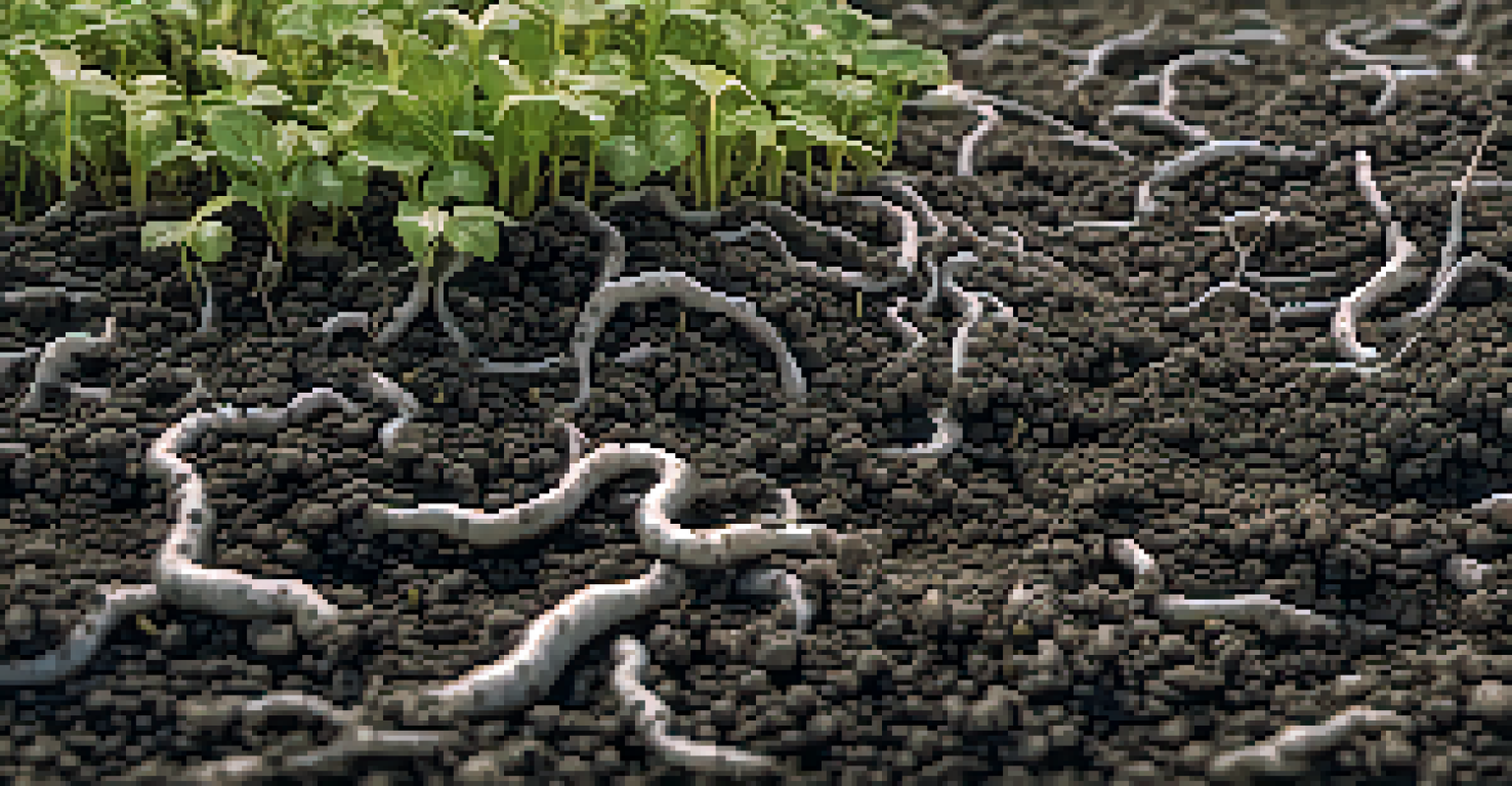Breeding Cover Crops for Soil Health and Environmental Resilience

Understanding Cover Crops and Their Benefits
Cover crops are plants grown primarily for the benefits they provide to the soil rather than for harvest. They play a crucial role in preventing soil erosion, improving soil structure, and enhancing nutrient availability. By covering the soil, they also suppress weeds, reducing the need for chemical herbicides, which is a win for both farmers and the environment.
Cover crops are a simple yet effective way to improve soil health and enhance agricultural sustainability.
These crops, such as clover and rye, contribute organic matter to the soil when they decompose, enriching it over time. This organic matter is vital for maintaining soil health, as it promotes microbial activity and improves water retention. In essence, cover crops act as a natural shield and a nutrient bank for the soil, ensuring that it remains fertile and productive.
Moreover, cover crops can help mitigate the effects of climate change by reducing carbon emissions and increasing carbon sequestration in the soil. By integrating these crops into farming practices, we pave the way for a more sustainable and resilient agricultural system that benefits both the land and the farmer.
The Science Behind Breeding Cover Crops
Breeding cover crops involves selecting and enhancing specific traits that optimize their benefits to soil health. This scientific approach ensures that these crops can thrive in various environments, resist pests, and adapt to climate variations. For instance, researchers might focus on breeding varieties that have deeper root systems to improve soil aeration and moisture retention.

An example of successful breeding is the development of drought-resistant cover crops. These varieties can withstand periods of low water availability, which not only helps farmers in arid regions but also enhances soil moisture for subsequent crops. This adaptation is crucial as climate change continues to alter weather patterns, making resilience a top priority for agriculture.
Cover Crops Enhance Soil Health
Cover crops prevent erosion, improve soil structure, and enrich nutrient availability, fostering a healthier agricultural ecosystem.
By leveraging modern breeding techniques alongside traditional practices, scientists can create cover crops that meet the specific needs of different ecosystems. This targeted approach not only improves soil health but also supports biodiversity, making it a key component of sustainable farming.
Selecting the Right Cover Crops for Your Soil
Choosing the right cover crop depends on various factors, including soil type, climate, and farming goals. For example, if you're dealing with sandy soils prone to erosion, oats or rye can offer excellent ground cover and stability. On the other hand, if your goal is to improve nitrogen levels, legumes like vetch or clover might be more suitable.
Healthy soils are the foundation of healthy food systems, and cover crops play a pivotal role in maintaining soil health.
It's also essential to consider the growth cycle of the cover crop in relation to your main crops. Some cover crops are quick to establish and can be sown between cash crops, while others may take longer to mature. Understanding these dynamics allows farmers to maximize the benefits of cover crops while minimizing competition for resources.
Additionally, local agricultural extensions and research institutions can provide invaluable insights into the best cover crop varieties for specific regions. By collaborating with these resources, farmers can make informed decisions that enhance soil health and contribute to long-term agricultural resilience.
The Role of Cover Crops in Soil Microbial Health
Soil health is heavily influenced by the presence of a diverse microbial community. Cover crops play a pivotal role in supporting this diversity by providing food and habitat for beneficial microorganisms. When cover crops decompose, they release compounds that stimulate microbial activity, which in turn enhances nutrient cycling and soil fertility.
For instance, certain cover crops can produce exudates that attract specific soil microbes, which aid in breaking down organic matter and releasing nutrients. This symbiotic relationship not only improves soil structure but also boosts plant health by ensuring that nutrients are available when needed. In essence, cover crops serve as a bridge between plants and soil microbes, fostering a thriving ecosystem.
Breeding Supports Crop Resilience
Selective breeding of cover crops enhances their adaptability to various environments, ensuring they provide optimal benefits for soil health.
Moreover, healthy microbial communities can help suppress soil-borne diseases and pests, reducing the need for chemical interventions. By promoting microbial health through cover cropping, farmers can create a more resilient agricultural system that supports both crop productivity and environmental sustainability.
Environmental Benefits of Cover Crops
Cover crops are not just beneficial for soil health; they also contribute significantly to environmental sustainability. By preventing soil erosion and reducing runoff, they help maintain water quality in nearby streams and rivers. This is particularly important in agricultural areas where nutrient runoff can lead to harmful algal blooms and other ecological issues.
Additionally, cover crops can improve carbon sequestration, helping to mitigate climate change. As plants grow, they absorb carbon dioxide from the atmosphere and store it in the soil. By incorporating cover crops into farming practices, we not only enhance soil health but also play a role in reducing greenhouse gas emissions.
Furthermore, the biodiversity fostered by cover cropping can enhance ecosystem resilience. A diverse agricultural landscape is better equipped to withstand pests, diseases, and extreme weather events, ensuring that farming remains viable in the face of future challenges. In this way, cover crops serve as a cornerstone for both healthy soils and a healthy environment.
Integrating Cover Crops into Crop Rotations
Integrating cover crops into crop rotations can significantly enhance farm productivity and sustainability. By alternating cash crops with cover crops, farmers can break pest and disease cycles while improving soil health year after year. This practice not only boosts yields but also reduces dependency on chemical inputs.
For example, after harvesting a cash crop like corn, a farmer might plant a cover crop such as radish. This not only prevents soil erosion during the off-season but also helps to break up compacted soil with its deep root system. When the radish decomposes, it adds organic matter back into the soil, preparing it for the next planting season.
Sustainable Farming Through Integration
Integrating cover crops into crop rotations boosts productivity, manages weeds, and enhances sustainability in farming practices.
Moreover, rotating cover crops with cash crops allows farmers to manage weeds more effectively. Different crops can suppress different types of weeds, leading to a more sustainable approach to weed control. This holistic strategy not only benefits the farm but also aligns with broader environmental goals.
Challenges and Solutions in Cover Crop Adoption
Despite the numerous benefits of cover crops, some farmers face challenges in adopting these practices. Concerns about the time and resources needed for planting and managing cover crops can be significant barriers. Additionally, there may be misconceptions about their cost-effectiveness and the potential impact on cash crop yields.
To address these challenges, education and outreach are crucial. Providing farmers with success stories, research-backed data, and hands-on training can help alleviate concerns. For instance, demonstrating the long-term financial benefits of improved soil health can encourage more farmers to incorporate cover crops into their practices.

Furthermore, developing local networks and support systems can facilitate the sharing of best practices among farmers. Collaborations with agricultural organizations can provide the necessary resources and expertise to help farmers overcome obstacles, making cover cropping a more attainable and beneficial strategy for everyone.